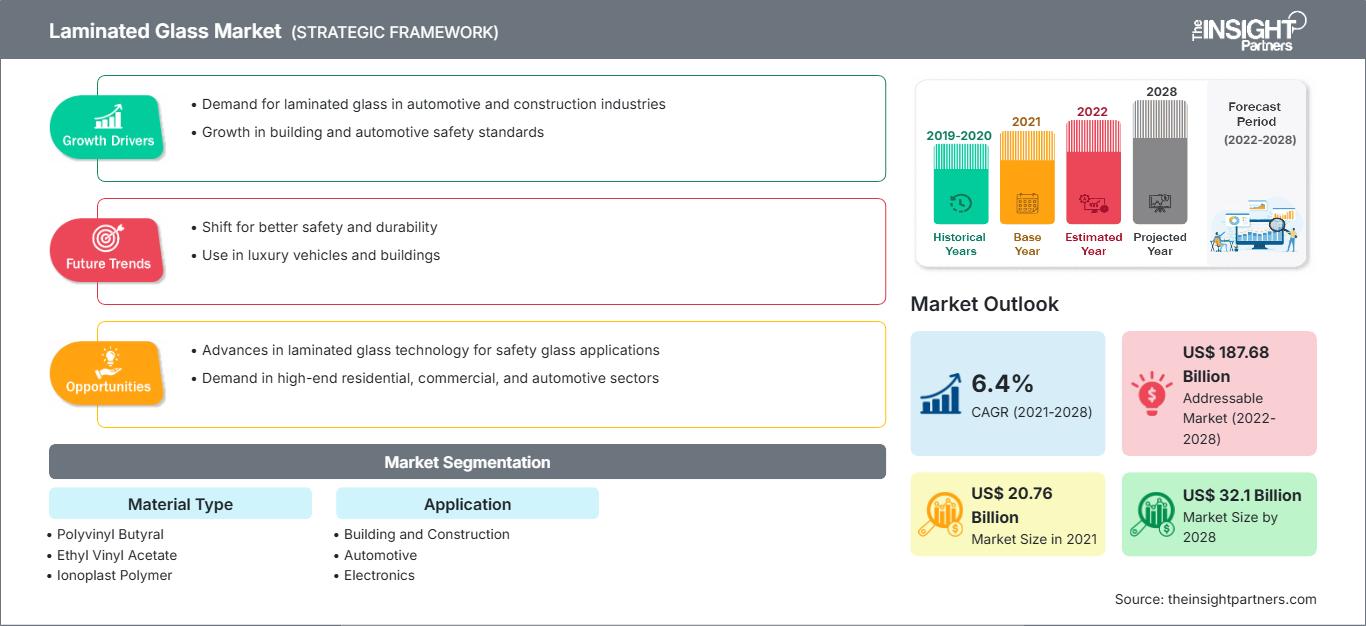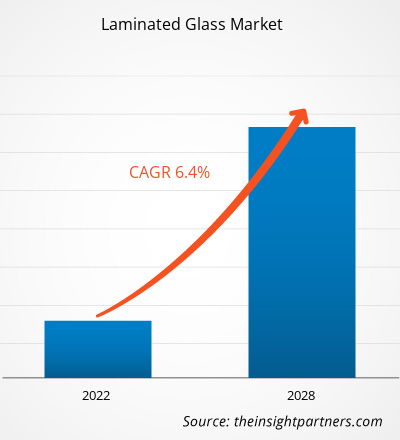Se proyecta que el mercado de vidrio laminado alcance los 32.100 millones de dólares en 2028, desde los 20.760 millones de dólares en 2021, y se espera que crezca a una CAGR del 6,4 % entre 2021 y 2028.
El vidrio laminado se prepara aplicando presión y calor a múltiples capas de vidrio termoendurecido o templado. El vidrio laminado está separado por una capa intermedia. Esta capa ayuda a mantener unidos los fragmentos de vidrio al recibir un impacto. El vidrio tiene amplias aplicaciones en industrias como la construcción, la automoción y la electrónica.
En 2020, Asia Pacífico registró la mayor participación en los ingresos del mercado mundial de vidrio laminado. El creciente número de proyectos de construcción residencial y comercial es el principal factor que contribuye al crecimiento del mercado en esta región. El consiguiente crecimiento de la industria de la construcción está impulsando la demanda de vidrio laminado en la región. Además, Asia Pacífico cuenta con una industria automotriz dominante y registra la mayor producción de vehículos de todas las regiones. El vidrio laminado se utiliza ampliamente en cubiertas de parabrisas en la industria automotriz, lo que genera oportunidades de negocio favorables para los fabricantes de vidrio laminado.
Obtendrá personalización en cualquier informe, sin cargo, incluidas partes de este informe o análisis a nivel de país, paquete de datos de Excel, así como también grandes ofertas y descuentos para empresas emergentes y universidades.
Mercado del vidrio laminado: perspectivas estratégicas

-
Obtenga las principales tendencias clave del mercado de este informe.Esta muestra GRATUITA incluirá análisis de datos, desde tendencias del mercado hasta estimaciones y pronósticos.
Impacto de la pandemia de COVID-19 en el mercado del vidrio laminado
La pandemia de COVID-19 afectó las economías e industrias de varios países debido a confinamientos, prohibiciones de viaje y cierres de negocios. La industria química y de materiales fue una de las principales que sufrió graves consecuencias, como interrupciones en las cadenas de suministro y cierres de plantas de producción. Se espera que la escasez del mercado del vidrio laminado se prolongue hasta 2021, causando interrupciones en diversos negocios. Además, muchas fábricas y fabricantes tuvieron que suspender o ralentizar la producción de vidrio, lo que dificultó enormemente satisfacer la demanda actual. La industria de la construcción ha sido la principal víctima de la escasez de vidrio. Durante el confinamiento, los residentes invirtieron tiempo y dinero en la reconstrucción o remodelación de sus hogares, lo que impulsó la demanda de materiales. Además, debido a las dificultades para adquirir vidrio, el negocio del vidrio laminado ha sufrido un revés significativo. Por lo tanto, la baja demanda de las industrias de consumo final durante la pandemia de COVID-19 ha provocado una desaceleración en el crecimiento del mercado del vidrio laminado.
Perspectivas del mercado
La creciente aplicación en la industria de la construcción impulsa el crecimiento del mercado del vidrio laminado.
La demanda de vidrio laminado en la industria de la construcción ha cobrado un impulso significativo debido al creciente uso del vidrio como elemento estructural y a la preferencia por diseños arquitectónicos más creativos. El uso del vidrio como elemento estructural en proyectos de construcción convencionales es cada vez más popular. El vidrio laminado se utiliza ampliamente en diversas aplicaciones interiores y exteriores en la industria de la construcción. Además, aumenta la seguridad y la durabilidad de los diseños modernos. La necesidad de mantener la seguridad en viviendas y edificios comerciales ha impulsado la demanda de vidrio de seguridad y otros productos de acristalamiento.
Perspectivas de la aplicación
Según su aplicación, el mercado global del vidrio laminado se segmenta en edificación y construcción, automoción, electrónica, paneles solares, entre otros. Este segmento ocupó la mayor cuota de mercado en 2020. El vidrio laminado se utiliza ampliamente en edificios residenciales y comerciales gracias a su resistencia y resistencia a la rotura. Su uso se incrementa en hoteles, terminales de aeropuertos y estudios de grabación gracias a sus propiedades de aislamiento acústico. Es probable que el crecimiento de la industria de la edificación y construcción, especialmente en regiones emergentes como Asia-Pacífico, impulse la demanda de vidrio laminado en los próximos años.
Entre los principales actores del mercado global de vidrio laminado se encuentran Asahi India Glass Limited; Cardinal Glass Industries, Inc.; Central Glass Co., Ltd.; Fuyao Group; Guardian Glass Llc; Press Glass Sa; Saint Gobain SA; Schott Ag; Taiwan Glass Group; y Xinyi Glass Holdings Limited. Los actores que operan en el mercado se centran en el desarrollo de productos innovadores y de alta calidad para satisfacer las necesidades de los clientes.
Informe destacado
- Tendencias progresivas de la industria en el mercado del vidrio laminado para ayudar a los actores a desarrollar estrategias efectivas a largo plazo.
- Estrategias de crecimiento empresarial adoptadas por los mercados desarrollados y en desarrollo
- Análisis cuantitativo del mercado del vidrio laminado de 2019 a 2028
- Estimación de la demanda mundial de vidrio laminado
- Análisis de las cinco fuerzas de Porter para ilustrar la eficacia de los compradores y proveedores que operan en la industria
- Desarrollos recientes para comprender el escenario del mercado competitivo
- Tendencias y perspectivas del mercado, así como factores que impulsan y restringen el crecimiento del mercado del vidrio laminado.
- Asistencia en el proceso de toma de decisiones destacando las estrategias de mercado que sustentan el interés comercial, lo que conduce al crecimiento del mercado.
- El tamaño del mercado de vidrio laminado en varios nodos
- Descripción detallada y segmentación del mercado, así como de la dinámica de la industria del vidrio laminado.
- Tamaño del mercado de vidrio laminado en diversas regiones con prometedoras oportunidades de crecimiento
Perspectivas regionales del mercado del vidrio laminado
Los analistas de The Insight Partners han explicado detalladamente las tendencias regionales y los factores que influyen en el mercado del vidrio laminado durante el período de pronóstico. Esta sección también analiza los segmentos y la geografía del mercado del vidrio laminado en América del Norte, Europa, Asia Pacífico, Oriente Medio y África, y América del Sur y Central.
Alcance del informe de mercado de vidrio laminado
| Atributo del informe | Detalles |
|---|---|
| Tamaño del mercado en 2021 | US$ 20.76 mil millones |
| Tamaño del mercado en 2028 | US$ 32.1 mil millones |
| CAGR global (2021-2028) | 6,4% |
| Datos históricos | 2019-2020 |
| Período de pronóstico | 2022-2028 |
| Segmentos cubiertos |
Por tipo de material
|
| Regiones y países cubiertos |
América del norte
|
| Líderes del mercado y perfiles de empresas clave |
|
Densidad de actores del mercado del vidrio laminado: comprensión de su impacto en la dinámica empresarial
El mercado del vidrio laminado está creciendo rápidamente, impulsado por la creciente demanda del usuario final debido a factores como la evolución de las preferencias del consumidor, los avances tecnológicos y un mayor conocimiento de los beneficios del producto. A medida que aumenta la demanda, las empresas amplían su oferta, innovan para satisfacer las necesidades del consumidor y aprovechan las tendencias emergentes, lo que impulsa aún más el crecimiento del mercado.

- Obtenga una descripción general de los principales actores clave del mercado de vidrio laminado
Segmentación del mercado de vidrio laminado:
Tipo de material
- Butiral de polivinilo
- acetato de etilo y vinilo
- Polímero ionoplástico
- TPU alifático
- Otros
Solicitud
- Construcción y edificación
- Automotor
- Electrónica
- Paneles solares
- Otros
Perfiles de empresas
- Asahi India Glass Limited
- Industrias de vidrio Cardinal, Inc.
- Compañía Central de Vidrio, Ltd.
- Grupo Fuyao
- Guardian Glass LLC
- Prensa Glass Sa
- Saint-Gobain SA
- Schott Ag
- Grupo de vidrio de Taiwán
- Xinyi Glass Holdings Limitada.
- Análisis histórico (2 años), año base, pronóstico (7 años) con CAGR
- Análisis PEST y FODA
- Tamaño del mercado, valor/volumen: global, regional y nacional
- Industria y panorama competitivo
- Conjunto de datos de Excel
Informes recientes
Informes relacionados
Testimonios
Razón para comprar
- Toma de decisiones informada
- Comprensión de la dinámica del mercado
- Análisis competitivo
- Información sobre clientes
- Pronósticos del mercado
- Mitigación de riesgos
- Planificación estratégica
- Justificación de la inversión
- Identificación de mercados emergentes
- Mejora de las estrategias de marketing
- Impulso de la eficiencia operativa
- Alineación con las tendencias regulatorias






















 Obtenga una muestra gratuita para - Mercado de vidrio laminado
Obtenga una muestra gratuita para - Mercado de vidrio laminado